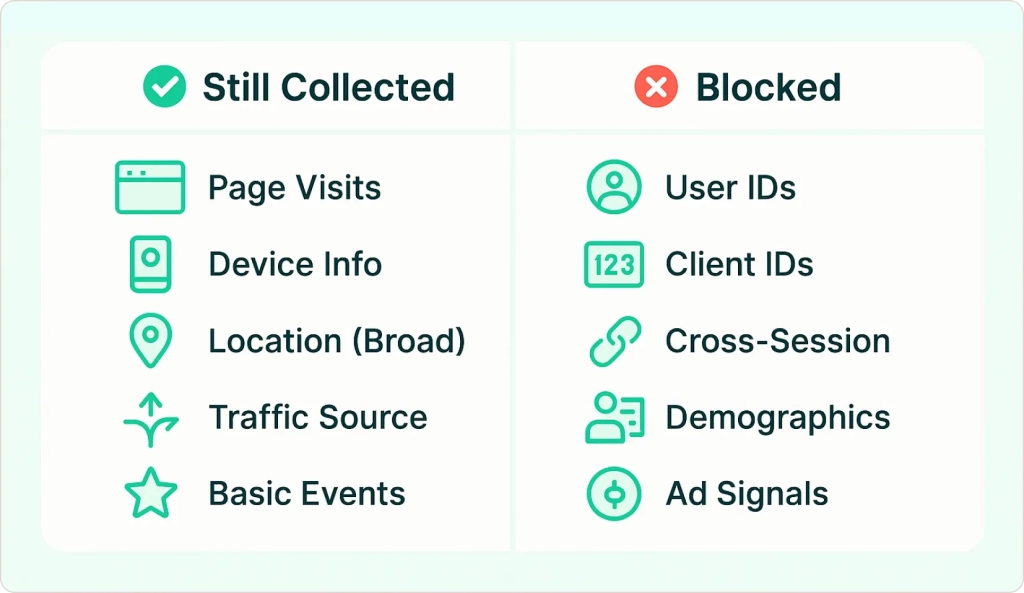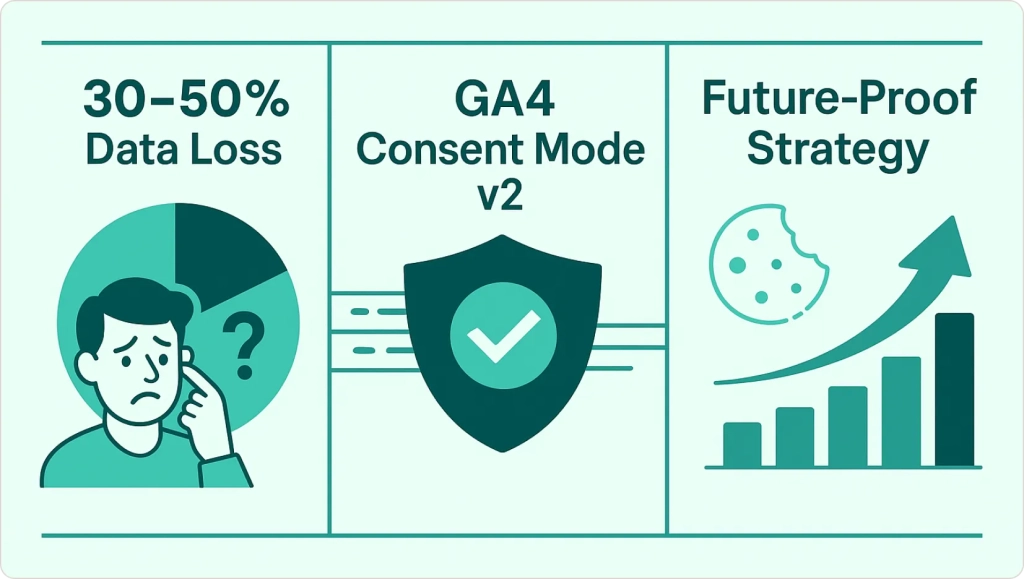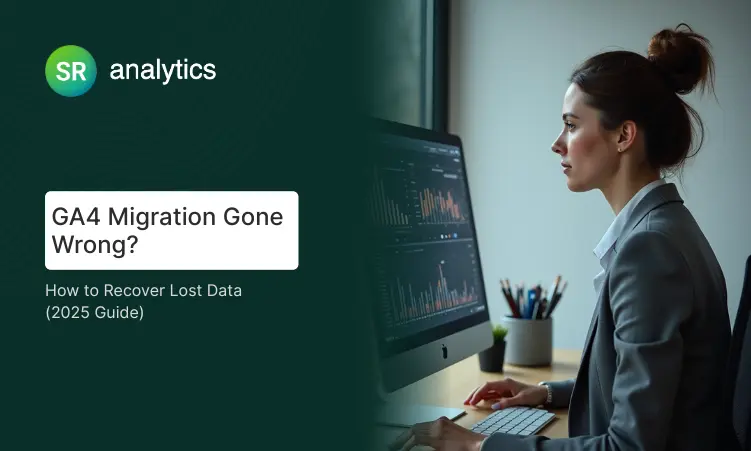Key Highlights
- GA4 consent mode still collects anonymous data even when consent is denied through cookieless pings
- Advanced consent mode GA4 enables behavioral modeling that recovers up to 70% of lost attribution data
- Proper implementation requires both CMP and GTM configuration to translate user choices into tag behavior
- GA4 denied consent data appears with special icons allowing marketers to distinguish observed vs estimated metrics
- Google’s march 2024 EU policy makes consent mode v2 mandatory for optimal ad performance
- Modeling requires minimum 1,000 consenting and 1,000 non-consenting users daily for 7 days to activate
🔍 Think your GA4 data disappears when users reject cookies? Think again.
I’ve seen countless marketers panic when privacy laws hit and their Google Analytics data started looking like Swiss cheese. “Are we flying blind now?” they ask when users hit “Reject All” on cookie banners. Here’s what I tell them: Not exactly.
Here’s what I’ve learned: When users deny consent, ga4 consent mode still sends anonymous “pings” containing non-PII info (page path, device/browser type, country) to maintain basic metrics. I like to think of GA4 consent as working in stealth mode – recording actions without identifying people.
In my experience working with hundreds of clients, those without this technology are indeed flying blind. I’ve witnessed conversion counts drop 20% after enforcing cookie consent, until ga4 consent mode recovered 9% back. Understanding GA4 consent functionality has become crucial for balancing data collection with privacy compliance in 2025.
In this guide, I’ll show you exactly what GA4 captures without consent, how GA4 consent modeling fills the gaps, and how to set up consent mode in google analytics without losing your sanity.
AI Overview :
GA4 Consent Mode sends anonymous pings when users deny consent, enabling behavioral modeling to estimate missing metrics. This recovers up to 70% of conversion attribution data while maintaining privacy compliance.
What is GA4 Consent Mode and How Does It Work?
After implementing Google consent mode for dozens of clients, I’ve learned it’s essentially a translator between your cookie banner and Google Analytics. When someone hits “reject,” GA4 consent doesn’t just shut everything down – it switches GA4 into what I call “anonymous mode” where GA4 consent can still track actions without tracking people.
According to Google’s official documentation, Consent Mode helps websites respect user consent preferences while still providing measurement capabilities through privacy-safe methods.
Basic vs Advanced: The Difference That Matters
From my implementations, I’ve seen two very different outcomes:
Basic consent mode: Nothing fires until GA4 consent is granted. Zero data, zero insights from non-consenting users. I tell clients it’s like turning off the lights completely – you’re stumbling in the dark.
Advanced consent mode GA4: This is where I’ve seen the GA4 consent magic happen. Tags fire immediately but in privacy-safe mode, sending anonymous pings until GA4 consent is given. Advanced consent mode ga4 captures essential data upfront and enables GA4 consent behavioral modeling – I’ve helped clients recover up to 70% of what they’d otherwise lose.
In my practice, since march 2024, advanced consent mode ga4 became Google’s recommended approach and is required for certain Google Ads features in the EU. GA4 consent mode v2 represents what I consider the latest evolution with enhanced privacy controls.
How It Actually Works
Here’s what I’ve observed happening behind the scenes when GA4 consent is processed:
- User sees your cookie banner
- If they accept: normal GA4 consent tracking kicks in
- If they deny: ga4 consent mode switches to anonymous pings only
- Google’s algorithms use these GA4 consent signals to estimate the full picture
- You get insights without compromising user privacy through GA4 consent compliance
What Data Can GA4 Still Collect?

When someone denies GA4 consent but advanced consent mode ga4 is active, I’ve found GA4 still captures specific data points. Here’s exactly what GA4 captures without consent based on my implementations:
The Anonymous Data Collection
- Page Visits & Timing: GA4 consent systems know “someone visited this page at this time” – just not who. This GA4 denied consent data provides essential timing information that I use for basic reporting.
- Technical Context: Device type, browser, operating system. In my experience, this gives enough data for basic reporting through GA4 consent anonymous tracking, but not enough to identify anyone.
- Location (Broad Strokes): Country/region info from anonymized IP addresses that GA4 consent processing includes. I’ve found this invaluable for geographic insights.
- Traffic Sources: UTM parameters and referrer data – though I’ve noticed GA4 consent attribution can get tricky if consent comes later in the session.
- Events Without Identity: Purchase events, form submissions, downloads – GA4 consent sees the action but can’t tie it to a person. I’ve helped e-commerce clients track conversions this way without compromising privacy.
As Search Engine Land reports, Google has actively enhanced GA4’s consent verification capabilities to help marketers better understand their implementation status.
What’s Completely Off-Limits
From my implementations, these are always blocked:
- User IDs, Client IDs, or any persistent identifiers in GA4 consent processing
- Cross-session tracking or return visitor recognition
- Demographic data or interest categories
- Personalized advertising signals
The Modeling Magic That Makes It Work
Here’s where GA4 consent gets clever, and I’ve seen this work beautifully. GA4 doesn’t just collect anonymous pings and call it a day – it uses machine learning to fill in the blanks when GA4 consent is denied.
The Core Concept: GA4 consent systems look at users who did consent, find patterns, then estimate what similar non-consenting users probably did. I describe it to clients as having a really smart statistician constantly running “what if” scenarios based on GA4 consent data.
What Gets Modeled
From my client work, I’ve seen modeling applied to:
- User counts and session estimates through GA4 consent modeling
- Engagement patterns and conversion likelihood
- Traffic source attribution when GA4 consent is limited
- Revenue and goal completions
Industry experts at MarTech emphasize that proper GA4 consent implementation is crucial for maintaining measurement accuracy in the post-cookie era – something I’ve witnessed firsthand.
The Catch: You Need Volume
GA4 consent modeling isn’t magic – I’ve learned it requires significant data. Google needs at least 1,000 consenting and 1,000 non-consenting users daily for 7 days before GA4 consent modeling kicks in. I’ve seen smaller sites show “(threshold not met)” until they hit these minimums.
The good news? When GA4 consent modeling works, I’ve helped businesses see an average 70% recovery of ad-click to conversion data that would otherwise vanish.
Why This Matters for Your Marketing in 2025

The Data Accuracy Problem
- In my consulting work, I’ve seen marketers without ga4 consent mode miss 30-50% of their actual performance. I always ask them: “Would you make budget decisions based on half the story when GA4 consent could provide much more?”
- With advanced consent mode ga4 and GA4 consent modeling, I help clients get a much clearer picture while respecting user choices. Following Google Analytics best practices ensures your GA4 consent implementation supports both compliance and optimization.
Compliance Isn’t Optional Anymore
- I’ve guided numerous EU clients through Google’s policy since march 2024 that makes GA4 consent mandatory for sites using Google Ads in Europe. I’ve seen what happens when you ignore GA4 consent requirements – your ad optimization suffers. According to HubSpot’s analysis, companies implementing GA4 consent properly see significant improvements in measurement while staying compliant – exactly what I’ve observed.
Future-Proofing Your Strategy
- I tell all my clients: third-party cookies are dying in 2025. GA4 consent mode v2 and GA4 consent modeling represent the future of privacy-compliant measurement. Master GA4 consent now with my guidance, or scramble to catch up later.
Setting Up Consent Mode: The Non-Technical Version
Here’s what I tell non-technical marketers: Your cookie banner needs to talk to GA4 consent through Google Tag Manager. If they don’t sync correctly, you’ll either lose data or break GA4 consent compliance.
Understanding how to set up consent mode in google analytics properly requires attention to several key steps that I’ve refined through countless implementations. The process to set up consent mode in google analytics involves coordinating your consent management platform with GA4 consent settings.
My 5-Step Process

Step 1: I always ensure your consent management platform (OneTrust, Cookiebot, etc.) supports GA4 consent integration. Most modern ones I work with handle GA4 consent signals properly.
Step 2: In Google Tag Manager, I configure GA4 consent initialization so GA4 knows to start in “anonymous mode” before the user makes a choice about GA4 consent.
Step 3: I configure your GA4 tags to respect GA4 consent signals – this is where advanced consent mode ga4 does its thing with GA4 consent processing.
Step 4: When users update their GA4 consent preferences, I make sure that choice gets passed to GA4 immediately for proper GA4 consent handling.
Step 5: I verify GA4 consent functionality works using GA4’s built-in consent monitoring tools when you set up consent mode in google analytics.
Technical implementation guidance from Simo Ahava’s blog provides detailed insights for developers who need to handle the actual GA4 consent setup.
Advanced Tips and Common Pitfalls
The Timing Trap I See Everywhere
The Problem: If your consent banner loads slowly or GA4 consent fires before consent is initialized, you’ll lose attribution data or double-count events in GA4 consent processing. I’ve debugged this issue countless times.
My Fix: I always load GA4 consent initialization first, everything else second. No exceptions for GA4 consent timing.
Don’t Forget the v2 Signals
GA4 consent mode v2 requires additional parameters (ad_user_data and ad_personalization) for Google Ads. I’ve seen clients miss these GA4 consent signals, causing ad campaigns to fail optimization even when GA4 consent analytics works fine.
Analytics experts at Bounteous highlight how GA4 consent mistakes can tank your data quality overnight – something I’ve unfortunately witnessed.
For agencies I consult with managing multiple clients, understanding how Google Analytics consultants in digital agencies approach GA4 consent challenges provides scalable solutions.
Conclusion
Privacy-first measurement doesn’t mean flying blind. Advanced consent mode ga4 gives you a sophisticated way to maintain analytics insights while respecting user choices through proper GA4 consent handling.
When I implement this correctly for clients, ga4 consent mode can recover up to 70% of the attribution data you’d otherwise lose. That’s the difference between making decisions based on half the story versus having a nearly complete picture thanks to what GA4 captures without consent.
As I tell every client: privacy regulations are tightening and cookies disappear in 2025, so mastering GA4 consent and consent mode v2 isn’t optional – it’s survival. If you only do one thing this year, make sure your GA4 consent implementation is bulletproof. While your competitors struggle with data gaps, you’ll be optimizing with 70% more visibility through proper GA4 consent configuration.
Professional Google Analytics Services can ensure your GA4 consent measurement strategy evolves correctly with these requirements – because getting GA4 consent wrong means flying blind in a data-driven world.














